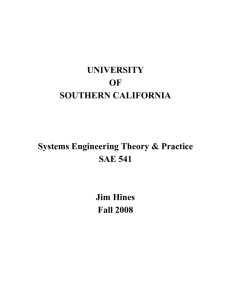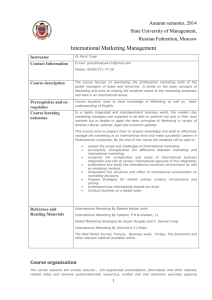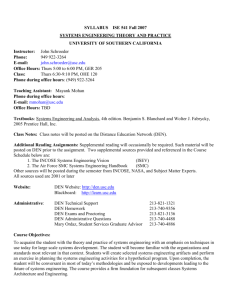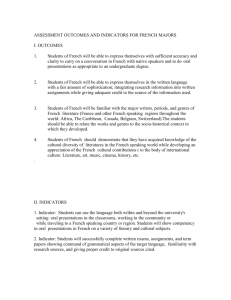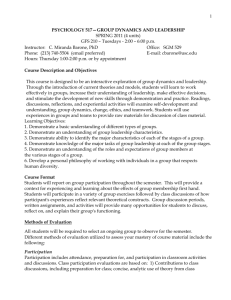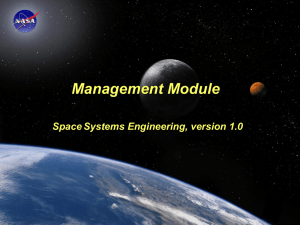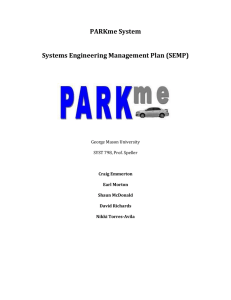Spring 2009 - Daniel J. Epstein Department of Industrial and
advertisement
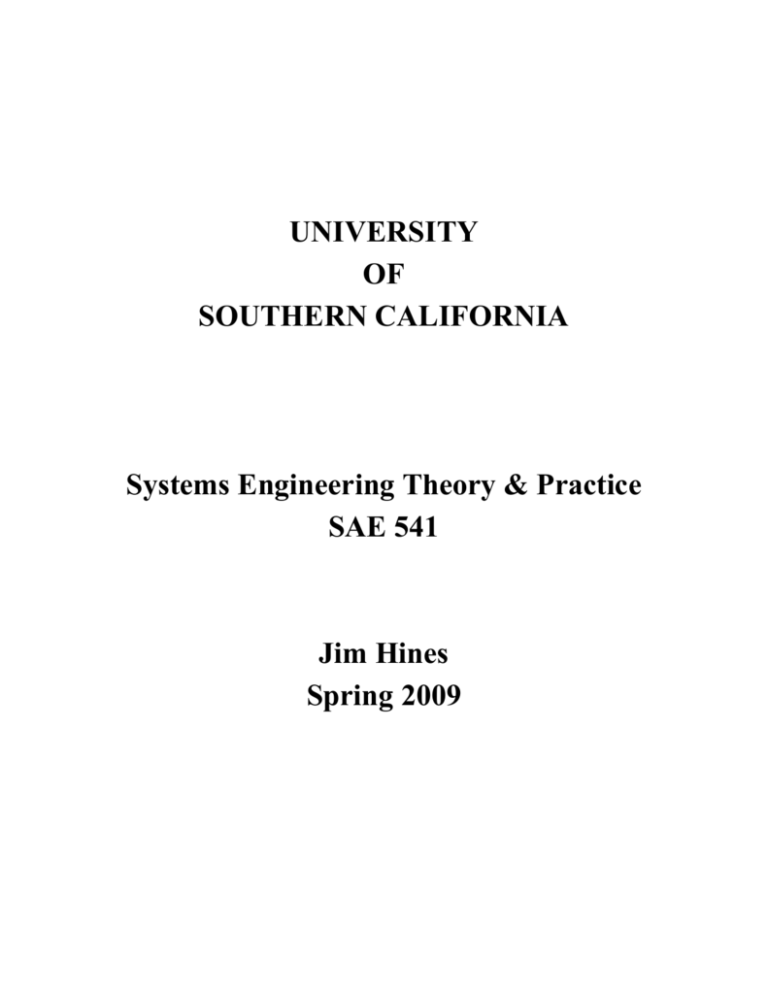
UNIVERSITY OF SOUTHERN CALIFORNIA Systems Engineering Theory & Practice SAE 541 Jim Hines Spring 2009 UNIVERSTY OF SOUTHERN CALIFORNIA COURSE OBJECTIVES AND REQUIREMENTS SYSTEMS ENGINEERING THEORY AND PRACTICE (SAE 541) Instructor: Jim Hines Phone: 562-714-4326 Email: jhines@usc.edu Office Hours: 5:30 PM Monday TA: Phone: Office Hours: Skype Messager: Email: Class: Tu 06:30 PM-09:10 PM Textbooks: 1. International Council of Systems Engineering, Systems Engineering Handbook, A guide for System Life Cycle Processes and Activities, version 3.1, August 2007 2. Defense Acquisition University, Systems Engineering Fundamentals, January 2001, Defense Acquisition University Press http://www.dau.mil/pubs/pdf/SEFGuide%2001-01.pdf 3. NASA Systems Engineering Handbook, June 1995, SP-6105 http://ocw.mit.edu/NR/rdonlyres/Aeronautics-and-Astronautics/16-892JFall-2004/9722DD5E-CDBB4B0F-8F5E-791CFF5FD359/0/nasasysenghbook.pdf Website: USC URL www.usc.edu/dept/engineering/Distance _Learning Blackboard https://learn.usc.edu Administrative: DEN Exams and Proctoring Denexam@usc.edu, (213) 821-3136 fax: (213) 821-0851 Technical Support webclass@usc.edu Online Services, Webcast Problems, Software Questions or General Technical Questions (213) 821-1321 Mary Ordaz, ISE Student Services Advisor, 213-740-4886 Course Description: Systems engineering is the evolving discipline that addressed the management of increasing complexity in military, industrial, commercial and civil systems. Over the past few decades, especially since the massive applications available from digital computers and software, the complexity of systems for a great variety of applications has threatened to overwhelm previous management processes. Furthermore, this complexity has resulted in developmental failures, cost overruns, schedule slippage, customer dissatisfaction and environmental disasters. Among the topics to be covered in the class are: ……………………..Perspectives of Systems and Systems Engineering ……………………..General Statement of the Complexity of a Problem ……………………..Integrated Product & Process Development ……………………..System Acquisition & Life Cycle ……………………..Definition Phase ……………………..Requirements & Functional Analysis ……………………..Specifications ……………………..Systems Engineering Management Plans ……………………..Design & Build Phase ……………………..Synthesis & Architecting ……………………..Verification, Validation, and Test ……………………..Systems Analysis & Control …………………….. Risk Management ……………………..Affordability ……………………..Design for Specialties ……………………..Integrated Master Plan & Schedule ……………………..Capability Maturity Models Course Objectives: Scope Systems Engineering is a scientific way to understand the underlying structure and characteristics of systems and their complexities. This course will acquaint you with concept of systems and the role systems engineering plays in their development. It will also provide a basic framework for planning and assessing system development and how systems analysis methods and techniques are integrated within the systems engineering process. Goals Establish a basic understanding of system and systems engineering concepts and terms Introduce systems engineering as a problem solving process and its relationship to program life cycle Discuss useful theories, models, techniques and tools Address design for operational feasibility (specialty engineering) concepts Present an overview of systems engineering management Course Highlights: (Detailed agenda for each session in Course Outline provided) There will be: 1) Exercises 2) Midterm exam. 3) Final exam. 4) Class Project These activities are to provide a valuable learning experience by demonstrating your knowledge, comprehension, application, analysis, synthesis, and evaluation of the subject material. You will be expected to apply systems thinking and utilize the systems engineering process during the course. As in the “real world” of systems engineering involves teamwork. As a result we will be forming teams for working on selected Exercises & the Class Project. Each team is required to demonstrate that they can perform selected Exercises and develop a Systems Engineering Management Plan (SEMP) or a Systems Specification. Each team will be required for their project make an initial “White Paper” presentation on their respective plans to the rest of the class. The white paper will contain the Subject matter, Team members, Table of Contents, Scope, Feasibility, and Applicable Documents. Presentation of the final project will be made during the last two sessions. You are encouraged and invited to utilize the knowledge acquired in the lectures, text and any other publications that are relevant to the development of your plan or specification, including those that are relevant to your everyday work. A written Systems Engineering Management Plan (SEMP) or a Systems Specification, representing the collective efforts of all team members, shall be submitted not later than the last class session. Reminder: It is important that the team demonstrate that the team knows “How to Write” a SEMP or Specification; not that it should be a final complete product. The final product should be a document which will guide others in preparing such a product in the future. Grading: USC Grading Policies shall be followed. Activity Weighting Factor Mid Term 25% 100 points Exercises 25% 100 points (5 pt/ 2 team presentations) Systems Engineering Management Plan / Systems Specification Project 25% 100 points (5 pt / team presentations of white paper and final project & 25 pt/ team member assessments) Final Exam 25% 100% 100 points Academic Integrity Statement - "The School of Engineering adheres to the University's policies and procedures governing academic integrity as described in USC Campus. Students are expected to be aware of and to observe the academic integrity standards described in USC Campus, and to expect those standards to be enforced in this course. Students with Disabilities: "Any Student requesting academic accommodations based on a disability is required to register with Disability Services and Programs (DSP) each semester. A letter of verification for approved accommodations can be obtained from DSP. Please be sure the letter is delivered to me (or to TA) as early in the semester as possible. DSP is located in STU 301 and is open 8:30 a.m. - 5:00 p.m., Monday through Friday. The phone number for DSP is (213)740-0776." University of Southern California Course Outline Systems Engineering Theory and Practice (SAE 541) Session 1: Introduction & Orientation– January 13, 2009 Introductory remarks on the nature and requirements of the course-and other administrative issues. ASSIGNMENTS: (before the class session) INCOSE Handbook: Preface & Chapters 1 DAU Handbook: Chapter 1, 3 NASA Handbook: Introduction, Fundamentals of Systems Engineering LECTURE CONTENT & OBJECTIVES (Introduction, System Definitions and Concepts) Definitions Why Systems Engineering? Systems Engineering Process & Products Be sure to turn in your Student Profiles before next class. Student Name Company & Location Phone/FAX Systems Engineering Experience E-mail Industry Experience Number of ISE Courses Taken Learning Style Objective http://www.howtolearn.com/lsinventory_student.html in Taking Course Personality http://www.humanmetrics.com/cgi-win/JTypes2.asp Other Comments Session 2: Introduction to Systems– January 20, 2009 ASSIGNMENTS (BEFORE THE CLASS SESSION): INCOSE: Chapters 2 & 3; Appendices A – F DAU: Chapters 2, 11, 19 & Supplementals, 20 NASA: The Project Cycle for Major NASA Systems Management Issues in Systems Engineering: Reviews, Audits & Control Gates Student Profile LECTURE TOPICS (Bringing Systems into Being) Application of Systems Engineering Systems Engineering Discipline The Systems Engineer and Project Manager Session 3: Introduction to Systems– January 27, 2009 ASSIGNMENTS (BEFORE THE CLASS SESSION): INCOSE: Chapters 2 & 3; Appendices A – F DAU: Chapters 2, 11, 19 & Supplemental 20 NASA: The Project Cycle for Major NASA Systems Management Issues in Systems Engineering: Reviews, Audits & Control Gates Student Profile LECTURE TOPICS (Bringing Systems into Being) Systems Acquisition & Life Cycle Design Reviews Session 4: Systems Design Process– February 3, 2009 ASSIGNMENTS (BEFORE THE CLASS SESSION): INCOSE Appendices I.5 & G.1 DAU: Chapter 8, 16, 17 NASA: Management Issues in Systems Engineering: Managing the Systems Engineering Process; Appendix B.1 Team Roster PROJECT TEAM ASSIGNMENTS (teams will be organized for the class project plans) LECTURE TOPICS (Conceptual Systems Design) Definition Phase Specifications Systems Engineering Management Plan (SEMP) Session 5: Systems Design Process (Cont.) – February 10, 2009 PROJECT TEAM ADJUSTMENTS – If required ASSIGNMENTS (BEFORE THE CLASS SESSION): INCOSE Chapters 4.1, 4.2, 4.3; Appendix I DAU: Chapter 4 LECTURE TOPICS (Conceptual & Preliminary System Design) Identification of Need (Mission Analysis) Quality Functional Deployment Session 6: Systems Design Process (Cont.) – February 17, 2009 PROJECT TEAM ADJUSTMENTS – If required ASSIGNMENTS (BEFORE THE CLASS SESSION): INCOSE: Appendix J DAU: Chapter 5 o NASA: Appendix B.7 LECTURE TOPICS (Conceptual & Preliminary System Design) Systems Requirements Analysis Functional Analysis & Allocation Session 7: “White Paper Presentations” February 24, 2009 ASSIGNMENTS o EXERCISE 1: REQUIREMENTS o EXERCISE 2: FUNCTIONAL ANALYSIS o WHITE PAPER PRESENTATIONS FROM PROJECT TEAMS Session 8: “White Paper Presentations” (Cont.) & Midterm March 3, 2009 ASSIGNMENTS TEAMAPER PRESENTATIONS FROM PROJECT TEAMS (CONT,) MIDTERM Session 9: Systems Design Process (Cont.) – March 17, 2009 ASSIGNMENTS BEFORE THE CLASS SESSION) INCOSE Chapter 4.4 – 4.9; Appendices K, N DAU: Chapter 6 & 7 NASA: Integrating Engineering Specialists Into the Systems Engineering Process: Verification: Appendices B.9 & B.10 LECTURE TOPICS (Detailed Design & Test) Design / Build Activities Synthesis / Architecting Verification & Validation Session 10: Systems Design Process (Cont.) – March 24, 2009 ASSIGNMENTS (BEFORE THE CLASS SESSION): INCOSE: Chapter 5.5 – 5.6 , 7 ; Appendix L DAU : Chapters 12, 13, 15 NASA : Systems Analyses and Modeling Issues ; Management Issues in Systems Engineering : Risk Management ; Appendix B.4 EXERCISE 3 : DESIGN SYNTHESIS EXERCISE 4: VERIFICATION LECTURE TOPICS (System Analysis) Trade Studies Effectiveness/ Cost Analysis Risk Analysis Session 11: Design for Operational Feasibility – March 31, 2009 READING ASSIGNMENT (BEFORE THE CLASS SESSION): INCOSE: Chapter 4.10 – 4.12, 9 & CAIV article, Appendix M NASA: Integrating Engineering Specialties Into the Systems Engineering Process; Appendix B.3, B.5, B.8 EXERCISE 5: TRADE STUDY EXERCISE 6: RISK MANAGEMENT LECTURE TOPICS (Design for Operational Feasibility) Affordability Design for Operational Feasibility (Specialty Engineering) Session 12: Systems Design Evaluation (Control) – April 7, 2009 ASSIGNMENTS (BEFORE THE CLASS SESSION) INCOSE: Chapter 5 & 8 DAU: Chapter 10, 14 NASA: Management Issues in Systems Engineering : Configuration Management, Status Reporting and Assessment , Appendix B.6 EXERCISE 7: AFFORDABILITY EXERCISE 8: SPECIALTY ENGINEERING LECTURE TOPICS (System Control) Baseline & Configuration Management Interface Management Technical Performance Measurements Quality & Control Concepts Session 13: Systems Engineering Management – April 14, 2009 ASSIGNMENTS (BEFORE CLASS SESSION): INCOSE Chapters 5; Appendix G & H DOD: Chapter 9, 18 & Supplementals NASA: Management Issues in Systems Engineering: Harmony of Goals, Work Products, and Organizations, The Work Breakdown Structure, Budgeting and Resource Planning, Scheduling; Appendix B.2 EXERCISE 9: TECHNICAL PERFORMANCE MEASUREMENT LECTURE TOPICS (SYSTEMS ENGINEERING PLANNING & ORGANIZATION AND PROGRAM MANAGEMENT AND CONTROL) Integrated Product & Process Development Work Breakdown Structure Integrated Master Plan and Integrated Master Schedule Capability Maturity Models Session 14: Team Presentations – April 21, 2008 ASSIGNMENTS EXERCISE 10: INTEGRATED PLANNING SUBMIT TWO (2) COPIES OF SEMP or SPECIFICATION FOR REVIEW AND GRADE TEAM PRESENTATIONS OF SEMP or SPECIFICATION Session 15: Team Presentations (Cont.) – April 28, 2008 TEAM PRESENTATIONS OF SEMP or SPECIFICATION Session 16: Final Exam – May 12, 2009 FINAL EXAM International Council of Systems Engineers (INCOSE) The International Council on Systems Engineering is a not-for-profit membership organization founded in 1990. INCOSE is an international authoritative body promoting the application of an interdisciplinary approach and means to enable the realization of successful systems. http://www.incose.org/ UNIVERSITY OF SOUTHERN CALIFORNIA SYSTEMS ENGINEERING MANAGEMENT PLAN (SEMP) & SYSTEMS REQUIREMENT DOCUMENT TEAM PROJECT INSTRUCTIONS & REQUIREMENTS RATIONALE: The Systems Engineering Management Plan (SEMP) guides and controls the technical efforts of a project. The SEMP reflects an integrated technical effort responsible for product development that balances all the factors with meeting a system’s life cycle requirements. The SEMP is a living document and needs to be structured to allow for ease of updating reflecting changes and progress throughout a stage of the life cycle. Technical requirements are documented through a series of specifications. The single most important engineering design document, defining the system functional baseline including the results from the needs analysis, feasibility analysis, operational requirements and the maintenance concept, top level functional analysis and allocation and identifying critical key performance parameters (KPPs) is the Systems Specification. Selection of the project may be based on the Students’ own development or possible related to one or more of the students’ area of work. The aim of the team systems engineering plan is to allow each student to apply the course concepts in a real world application. The following guidelines should be observed. GUIDELINES: Each team should develop the concept or idea collectively, by adhering to the following criteria: The project must involve at least the entire team as full time persons over the project’s duration. The delivered document shall address a system whose life cycle would be sufficient enough to consist of full time engineering tasks for at least 6 months or longer. The portion of the life cycle addressed should cover acquisition through its life cycle. The plan may contain both “internal” labor and “external” (or subcontracted) services. Subcontracting for services is very much in keeping with current IPPD practices. The students may draw upon a problem, project concept or non-executed project related to his/her work, providing these conditions are met: The choice of the project must not involve disclosure of proprietary information or other data of a proprietary nature peculiar to the organization. Students may draw upon studies related to an implemented project, document such use, or draw upon components of a larger project in which the student is involved. HOW TO DECIDE/SELECT A PROJECT: First, examine possible problems to be solved / topics based upon a discussion with your team members and your instructor; you may have a number of very workable problems available to you. Here are some problems or topics to consider: Development of a new or modifying an existing product Creating or modifying an existing system Automation of an existing system Case Studies provided The more critical items to consider in selecting the topical area for your project are: 1. You are interested in the problem to be solved or a project’s concept(s). Reminder you will use the project throughout this course. 2. There is enough substance in the project, organizational relevance, or institutional basis, to justify the time and effort. SELECTION OF TEAM MEMBERS: The information you provided in the STUDENT PROFILES is used for creating the Project Teams. Several criteria will be used, Including Similarity of interest or industry in which team members are employed Diversity in level of systems engineering experience and of academic study Note: Optionally the students may wish to organize their own teams with minimum instructor intervention. WHAT’S EXPECTED OF EACH TEAM? WHAT SHOULD EACH PROJECT PLAN ENTAIL? The “white paper” for the SEMP or SPECIFICATION is due in Session #6 and presentations shall be made in Sessions #6 and #7 if needed. The final project is due Session #13 and presentations shall be made in Sessions #13 & #14 if needed. Each team shall present its report to the rest of the class. The observing students and the instructor shall play the role of senior corporate managers performing an internal design review. You are encouraged to comment or ask or ask questions of the project team making the presentation. Your instructor shall also be the moderator. The use of visual aids or handouts is up to the discretion of the presenting teams. It is strongly suggested that you set up a schedule for your project’s completion. This is not only good practice, it will give you a sense of what a schedule means. Session 6 & 7 if needed – Initial “White Paper” Presentation After getting together and selecting a project, each team shall develop a top-level “White Paper” proposal, which should incorporate the following elements. This presentation simulates the act of “defining the problem” and “performing the process planning” of the project: The “paper” shall be orally presented to the class in any form or media the presenting team decides. Much of the content developed for this session’s presentation should be salvageable for final plan or specification. Session 13 & 14 if needed – Final Presentations This presentation highlights the important “How To” points of the written SEMP or SPECIFICATION, which shall be submitted in Session 13. EACH TEAM MEMBER WILL BE ASKED TO ASSESS EACH OTHER’S CONTRIBUTION AS TO THE TEAM’S CONTRIBUTION BY ALL MEANS, IF YOU HAVE QUESTIONS ON THE LEVEL OF DETAIL, FORMATS, OR EXPECTED STANDARDS ASK.
